When you develop peripheral artery disease (PAD), your extremities, usually your legs, don’t receive enough blood flow to keep up with demand. This causes symptoms, most notably leg pain when walking (claudication).
Peripheral artery disease is also likely to be a sign of a more widespread accumulation of fatty deposits in your arteries (atherosclerosis). This condition may be reducing blood flow to your kidney, heart and brain, as well as your legs.
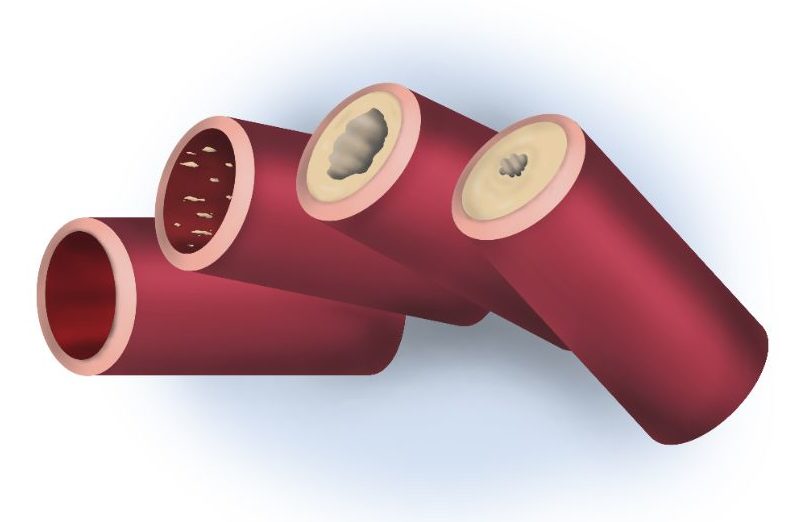
Symptoms
While many people with peripheral artery disease have mild or no symptoms, some people have leg pain when walking (claudication).
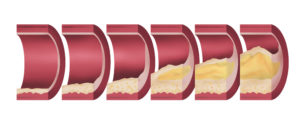 Claudication symptoms include muscle pain or cramping in your legs or arms that’s triggered by activity, such as walking, but disappears after a few minutes of rest. The location of the pain depends on the location of the clogged or narrowed artery. Calf pain is the most common location.
Claudication symptoms include muscle pain or cramping in your legs or arms that’s triggered by activity, such as walking, but disappears after a few minutes of rest. The location of the pain depends on the location of the clogged or narrowed artery. Calf pain is the most common location.
The severity of claudication varies widely, from mild discomfort to debilitating pain. Severe claudication can make it hard for you to walk or do other types of physical activity.
Signs include:
- Painful cramping in one or both of your hips, thighs or calf muscles after certain activities, such as walking or climbing stairs (claudication)
- Leg numbness or weakness
- Coldness in your lower leg or foot,
- Sores(ulcers) on your toes, feet or legs that won’t heal
- Dry gangrene, black discoloration of the toes or foot
- A change in the color of your legs
- Hair loss or slower hair growth on your feet and legs
- Slower growth of your toenails
- Shiny skin on your legs
- No pulse or a weak pulse in your legs or feet
- Erectile dysfunction in men
- If peripheral artery disease progresses, pain may even occur when you’re at rest or when you’re lying down (ischemic rest pain). It may be intense enough to disrupt sleep. Hanging your legs over the edge of your bed or walking around your room may temporarily relieve the pain.
Causes
Development of atherosclerosis
Peripheral artery disease is often caused by atherosclerosis. In atherosclerosis, fatty deposits (plaques) build up on your artery walls and reduce blood flow.
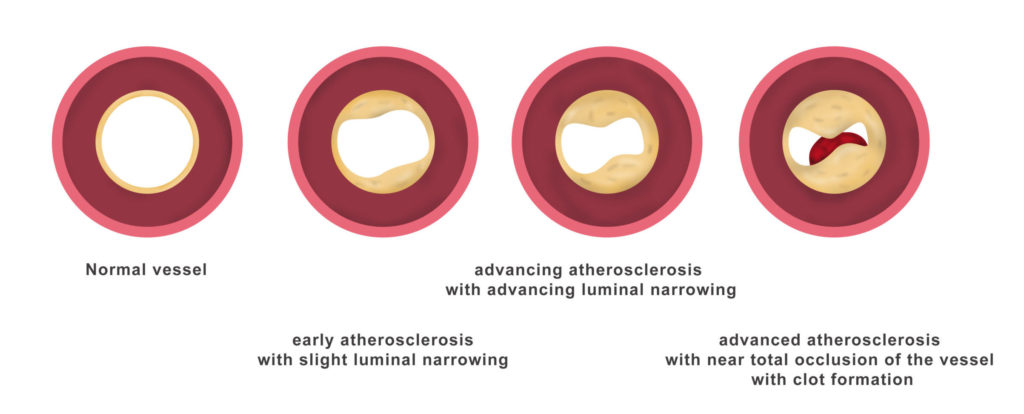
Although discussions of atherosclerosis usually focus on the heart, the disease can and usually does affect arteries throughout your body. When it occurs in the arteries supplying blood to your limbs, it causes peripheral artery disease.
Less commonly, the cause of peripheral artery disease may be blood vessel inflammation, injury to your limbs, unusual anatomy of your ligaments or muscles, or radiation exposure.
Risk factors
- Smoking
- Diabetes
- Obesity (a body mass index over 30)
- High blood pressure
- High cholesterol
- Increasing age, especially after reaching 50 years of age
- A family history of peripheral artery disease, heart disease or stroke
- High levels of homocysteine, a protein component that helps build and maintain tissue
- People who smoke or have diabetes have the greatest risk of developing peripheral artery disease due to reduced blood flow.
Complications
Peripheral artery disease is caused by a buildup of plaques in your blood vessels (atherosclerosis), you’re also at risk of developing:
Critical limb ischemia. This condition begins as open sores ress and cause tissue death (gangrene), sometimes requiring amputation of the affected limb.

Stroke and heart attack. The atherosclerosis that causes the signs and symptoms of peripheral artery disease isn’t limited to your legs. Fat deposits also build up in arteries supplying blood to your heart and brain.
Prevention
- Stop smoking if you’re a smoker.
- If you have diabetes, keep your blood sugar in good control.
- Exercise regularly. Aim for 30 to 45 minutes several times a week
- Lower your cholesterol and blood pressure levels, if applicable.
- Eat foods that are low in saturated fat.
- Maintain a healthy weight.
Diagnosis
Some of the tests your doctor may rely on to diagnose peripheral artery disease are:
- Physical exam. Your doctor may find signs of PAD during a physical examination, such as a weak or absent pulse below a narrowed area of your artery, whooshing sounds (bruits) over your arteries that can be heard with a stethoscope, evidence of poor wound healing in the area where your blood flow is restricted, and decreased blood pressure in your affected limb.
- Ankle-brachial index (ABI). This is a common test used to diagnose PAD. It compares the blood pressure in your ankle with the blood pressure in your arm.
- To get a blood pressure reading, your doctor uses a regular blood pressure cuff and a special ultrasound device to evaluate blood pressure and flow.
- You may walk on a treadmill and have readings taken before and immediately after exercising to capture the severity of the narrowed arteries during walking.
- Ultrasound. Special ultrasound imaging techniques, such as Doppler ultrasound, can help your doctor evaluate blood flow through your blood vessels and identify blocked or narrowed arteries.
- Angiography. Using a dye (contrast material) injected into your blood vessels, this test allows your doctor to view blood flow through your arteries as it happens. Your doctor is able to trace the flow of the contrast material using imaging techniques, such as X-ray imaging or procedures called magnetic resonance angiography (MRA) or computerized tomography angiography (CTA).
- Catheter angiography is a more invasive procedure that involves guiding a catheter through an artery in your groin to the affected area and injecting the dye that way. Although invasive, this type of angiography allows for simultaneous diagnosis and treatment. After finding the narrowed area of a blood vessel, your doctor can then widen it by inserting and expanding a tiny balloon or by administering medication that improves blood flow.
- Blood tests. A sample of your blood can be used to measure your cholesterol and triglycerides and to check for diabetes.
Treatment
Treatment for peripheral artery disease has two major goals:
- Manage symptoms, such as leg pain, so that you can resume physical activities
- Stop the progression of atherosclerosis throughout your body to reduce your risk of heart attack and stroke
You may be able to accomplish these goals with lifestyle changes, especially early in the course of peripheral artery disease. If you smoke, quitting is the single most important thing you can do to reduce your risk of complications.
If you have signs or symptoms of peripheral artery disease, you likely will need additional medical treatment. Your doctor may prescribe medicine to prevent blood clots, lower blood pressure and cholesterol, and control pain and other symptoms.
Medications
- Cholesterol-lowering medications. You may take a cholesterol-lowering drug called a statin to reduce your risk of heart attack and stroke.
- The goal for people who have peripheral artery disease is to reduce low-density lipoprotein (LDL) cholesterol, the “bad” cholesterol, to less than 100 milligrams per deciliter (mg/dL), or 2.6 millimoles per liter (mmol/L). The goal is even lower if you have additional major risk factors for heart attack and stroke, especially diabetes or continued smoking.
- High blood pressure medications. If you also have high blood pressure, your doctor may prescribe medications to lower it.
- A blood pressure reading, given in millimeters of mercury (mm Hg), has two numbers. The top number in the reading measures the pressure in your arteries when your heart beats (systolic pressure). The bottom number in the reading measures the pressure in your arteries between beats (diastolic pressure).
- Your blood pressure treatment goal should be less than 130/80 mm Hg. This is the guideline for anyone with coronary artery disease, diabetes or chronic kidney disease. Achieving 130/80 mm Hg is also the goal for healthy adults age 65 and older and healthy adults younger than age 65 with a 10 percent or higher risk of developing cardiovascular disease in the next 10 years.
- Medication to control blood sugar. If you also have diabetes, it becomes even more important to control your blood sugar (glucose) levels. Talk with your doctor about what your blood sugar goals are and what steps you need to take to achieve these goals.
- Medications to prevent blood clots. Because peripheral artery disease is related to reduced blood flow to your limbs, it’s important to improve that flow.
- Your doctor may prescribe daily aspirin therapy or another medication.
- Symptom-relief medications. They increase blood flow to the limbs both by keeping the blood thin and by widening the blood vessels. They specifically help treat symptoms of claudication, such as leg pain, for people who have peripheral artery disease. Common side effects of these medications include headache and diarrhea.
Atherectomy
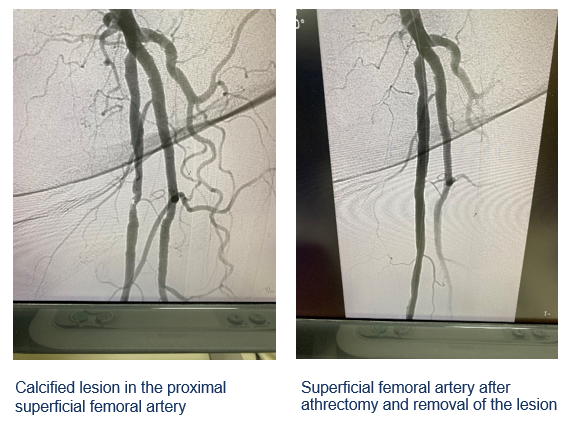
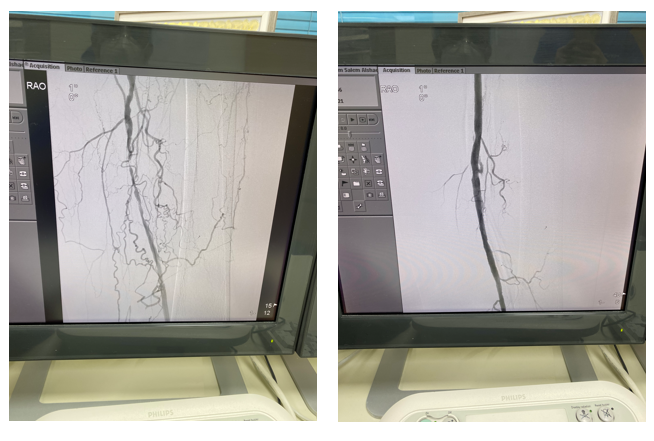
Angioplasty and surgery
Graft bypass for peripheral artery disease
In some cases, angioplasty or surgery may be necessary to treat peripheral artery disease that’s causing claudication:
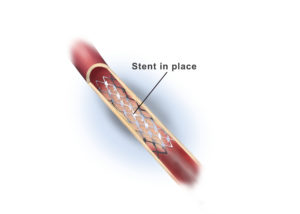

Angioplasty. In this procedure, a small hollow tube (catheter) is threaded through a blood vessel to the affected artery. There, a small balloon on the tip of the catheter is inflated to reopen the artery and flatten the blockage into the artery wall, while at the same time stretching the artery open to increase blood flow.
Your doctor may also insert a mesh framework called a stent in the artery to help keep it open. This is the same procedure doctors use to open heart arteries.
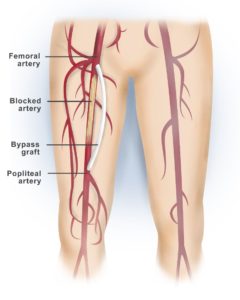 Bypass surgery. Your doctor may create a graft bypass using a vessel from another part of your body or a blood vessel made of synthetic (man-made) fabric. This technique allows blood to flow around or bypass the blocked or narrowed artery.
Bypass surgery. Your doctor may create a graft bypass using a vessel from another part of your body or a blood vessel made of synthetic (man-made) fabric. This technique allows blood to flow around or bypass the blocked or narrowed artery.
Thrombolytic therapy. If you have a blood clot blocking an artery, your doctor may inject a clot-dissolving drug into your artery at the point of the clot to break it up.
Supervised exercise program
In addition to medications or surgery, your doctor likely will prescribe a supervised exercise training program to increase the distance you can walk pain-free. Regular exercise improves symptoms of PAD in a number of ways, including helping your body use oxygen more efficiently.
Careful foot care
In addition to the above suggestions, take good care of your feet. People with peripheral artery disease, especially those who also have diabetes, are at risk of poor healing of sores and injuries on the lower legs and feet.
Poor blood circulation can postpone or prevent proper healing and increases the risk of infection. Follow this advice to care for your feet:
- Wash your feet daily, dry them thoroughly and moisturize often to prevent cracks that can lead to infection. Don’t moisturize between the toes, however, as this can encourage fungal growth.
- Wear well-fitting shoes and thick, dry socks.
- Promptly treat any fungal infections of the feet, such as athlete’s foot.
- Take care when trimming your nails.
- Inspect your feet daily for injuries.
- Have a foot doctor (podiatrist) treat bunions, corns or calluses.
- See your doctor at the first sign of a sore or injury to your skin.
- Alternative medicine


